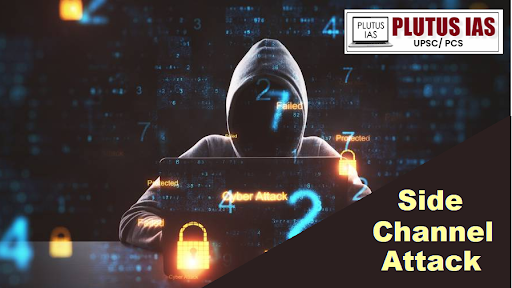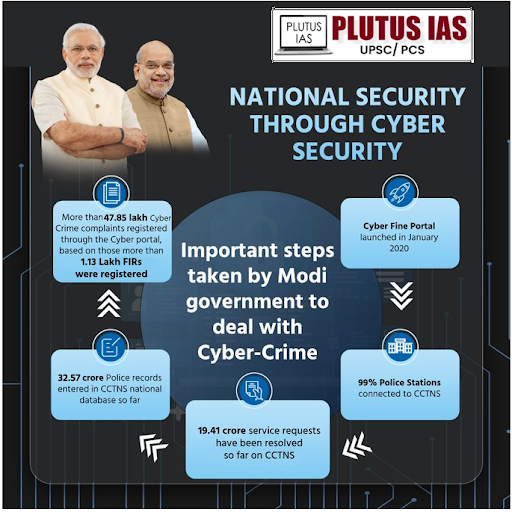09 Nov “Side-Channel Attacks: Emerging Threats to India’s Cybersecurity and Internal Security”
This article covers “Daily Current Affairs” and topic details A side-channel attack”
Syllabus mapping:
GS-3: Internal Security: Challenges to internal security through communication networks; the role of media and social networking sites in internal security challenges; basics of cyber security.
For Prelims:
What are the side Channel attacks, their types, and terminologies related to the side-channel attacks?
For Mains:
What are the threats from the Side- side-channel attack to the internal security, challenges in the tackling of the side-channel attack, and government measures to tackle the side-channel attack?
Why in the News?
New Agreement for Cybersecurity R&D: The Centre for Development of Telematics (C-DOT) has signed an agreement with C R Rao Advanced Institute of Mathematics, Statistics and Computer Science (AIMSCS) to develop an advanced cybersecurity solution, the Side Channel Leakage Capture Infrastructure and Analysis (SCLCIA). This collaboration aims to strengthen India’s defense against side-channel attacks.

What is a Side-Channel Attack?
A side-channel attack is a cyber-attack where attackers exploit unintended information leaks from a system—such as power usage, timing, or electromagnetic emissions—rather than directly targeting the software or hardware. By observing physical indicators of a system’s operations, attackers can extract sensitive data, making these attacks particularly stealthy and dangerous, especially in high-security environments.
Mechanism: These attacks primarily target cryptographic systems, as they handle sensitive data that can be indirectly observed. By analyzing “side channels” like energy emissions, sound, or light, attackers can uncover confidential data, such as encryption keys or passwords, without altering or infiltrating the system’s code, often evading traditional detection methods.
Examples of Side-Channel Attacks
Power Analysis Attack: Observes variations in power consumption by a device to deduce operations such as encryption key generation.
Timing Attack: Measures the time taken to execute specific computations to determine sensitive information, such as cryptographic keys.
Electromagnetic (EM) Attack: Uses electromagnetic emissions from a device to reconstruct operations and potentially infer data being processed.
Acoustic Cryptanalysis: Analyzes sounds made by computer components (like CPU or hard drives) to infer data being processed or commands being executed.
Cache Timing Attack: Exploits cache usage patterns in multi-core processors, where shared cache access may leak data between cores.
Optical Side-Channel Attack: Observes light emitted from devices, such as LEDs on network devices or routers, which can reveal information about network traffic or device status.

Threat to India’s Internal Security from Side-Channel Attacks
Threat to Critical Infrastructure:
Side-channel attacks can reveal vulnerabilities in critical infrastructure, such as power grids, telecom networks, and transportation systems.
If attackers gain sensitive operational data from these systems, they could disrupt services, impacting internal security, public safety, and economic stability.
National Defense Risks:
Defense systems heavily rely on cryptographic protocols for secure communications and data processing.
Side-channel attacks on defense technologies, including encryption devices, can lead to data leaks, facilitating espionage and potentially compromising national security.
Financial System Vulnerabilities:
The financial sector’s use of encryption mechanisms for transactions makes it vulnerable to side-channel attacks.
Leaked cryptographic keys can enable unauthorized access to confidential financial data, heightening the risk of fraud, financial instability, and reduced public trust in digital banking.
Intelligence and Government Communications:
Side-channel vulnerabilities in government and intelligence agency equipment could lead to sensitive information leaks.
Breaches in encryption protocols used in government communications may expose strategies, intelligence, and classified data to adversaries, making it critical to secure these channels.
IoT and Smart City Risks:
Increased IoT adoption in critical sectors, such as smart cities, healthcare, and traffic systems, introduces more points of vulnerability.
Side-channel attacks on IoT devices in these areas can lead to large-scale disruptions. For instance, compromised data from traffic or healthcare IoT devices could threaten public safety and security.
Supply Chain and Infrastructure Weaknesses:
India’s digitalization drive often relies on foreign technology imports, which may lack adequate protection against side-channel attacks.
Foreign technology components could expose internal systems without robust security measures, making indigenous solutions critical to safeguard national infrastructure.
Economic Impact and Data Sovereignty:
Frequent side-channel data breaches can lead to intellectual property theft and hinder economic growth.
Weak protections against these attacks threaten India’s digital economy and data sovereignty, as uncontrolled access to critical national data by external entities could jeopardize internal security and control over key information assets.
Government of India’s Initiatives for Cybersecurity

National Cyber Security Policy: Outlines comprehensive strategies to protect cyberspace infrastructure, prevent cyber attacks, and enable effective responses.
Indian Cyber Crime Coordination Centre (I4C): Provides a framework for law enforcement agencies to collaborate and combat cyber crimes across India.
Computer Emergency Response Team (CERT-In): Acts as the national cyber incident response agency, operating a 24/7 help desk, issuing threat alerts, coordinating responses, and collaborating internationally for threat information sharing.
Cyber Swachhta Kendra: Operated by CERT-In, this initiative focuses on securing India’s digital environment by identifying and removing cybersecurity threats.
Cyber Surakshit Bharat Initiative: Promotes cybersecurity awareness, particularly among IT staff and Chief Information Security Officers (CISOs), to enhance cyber hygiene in government and critical sectors.
Research and Development Programs: Supports R&D in cybersecurity fields like cryptography, network security, cyber forensics, and capacity building, aiming to advance secure technology and forensic tools domestically.
Capacity Development and Training: Establishes specialized training centers for cybercrime investigation, forensic labs, and virtual training environments across states to strengthen law enforcement capabilities in handling cyber crimes.
International and National Collaboration: Partners with industry bodies (CII, NASSCOM) and international cybersecurity agencies. Cybersecurity cooperation agreements and cyber drills have been conducted with countries like the US, Japan, and South Korea to enhance response and preparedness.
Challenges in Tackling Side-Channel Attacks
Detection Difficulty: These attacks are challenging to detect, as they do not leave traditional cyber footprints and often require sophisticated tools for identification.
High Cost of Countermeasures: Implementing physical protections, such as shielding or noise generators, can be expensive and technically demanding.
Impact on Device Performance: Many protective measures can reduce device performance, posing a challenge in high-performance environments.
Limited Awareness and Training: Many organizations may not fully understand the threat of side-channel attacks, leading to inadequate protection.
Evolving Attack Methods: Attackers continuously develop new techniques, requiring constant adaptation in defenses and countermeasures.
Complex Hardware Requirements: Defending against side-channel attacks often involves hardware-specific solutions, which may not be feasible across all devices or cost-effective.
Measures Needed to Strengthen Cybersecurity Further
Advanced Wireless Security: Implementing tools to detect rogue access points, disabling SSID broadcasting, using 802.1x for authentication, and restricting personal device access through administrator authorization can enhance wireless security.
Enhanced Incident Response: Building capacity for early warning and quick response to incidents through expanded CERT-In services and increased collaboration with international CERTs.
Cybersecurity Awareness for Citizens: Broader public awareness campaigns, like CERT-In’s “secureyourpc. in” initiative, can educate citizens on personal cybersecurity practices.
Cyber Forensic Tools Development: Further investment in developing advanced cyber forensic tools is needed to improve investigation capabilities, especially for tackling sophisticated cybercrimes.
Strengthening IoT Security: As IoT adoption rises, measures to secure IoT devices in critical sectors (e.g., healthcare, and infrastructure) will be essential to prevent potential side-channel and other cyber attacks.
Cybersecurity Standards for Import Technology: Given the reliance on foreign technology, establishing standards for imported hardware and software can reduce vulnerabilities, especially in critical infrastructure.
Continuous Capacity Building: More comprehensive training for law enforcement, judiciary, and IT staff across regions will ensure a well-prepared workforce to handle evolving cyber threats.
Conclusion:
As India’s digital footprint grows, it holds immense potential for driving economic growth and enhancing social well-being. However, this expansion also brings complex challenges to national security and sovereignty, as digital vulnerabilities can be exploited by cyber threats. A secure cyberspace demands a holistic approach involving not only government initiatives and international collaborations but also heightened public awareness and proactive cybersecurity measures.
Download plutus ias current affairs eng med 9th Nov 2024
Prelims Questions:
Q. The term “Side Channel Leakage Capture Infrastructure” recently seen in the news is related to
A. Money market
B. Climate change
C. Cyber security
D. Investment model
ANSWER: C
Mains question:
Q. What are the different elements of cyber security? Keeping in view the challenges in cyber security, examine the extent to which India has successfully developed a comprehensive National Cyber Security Strategy. ( 2022)



No Comments